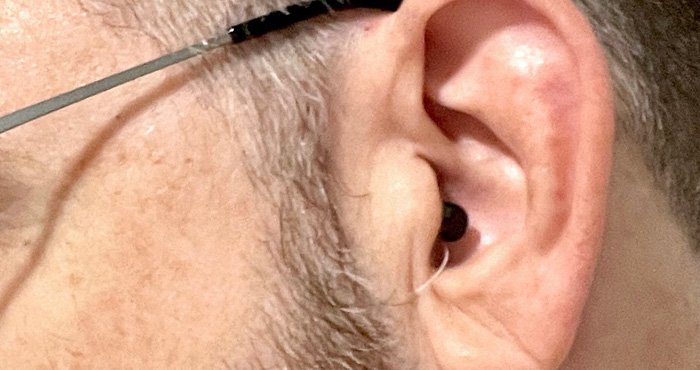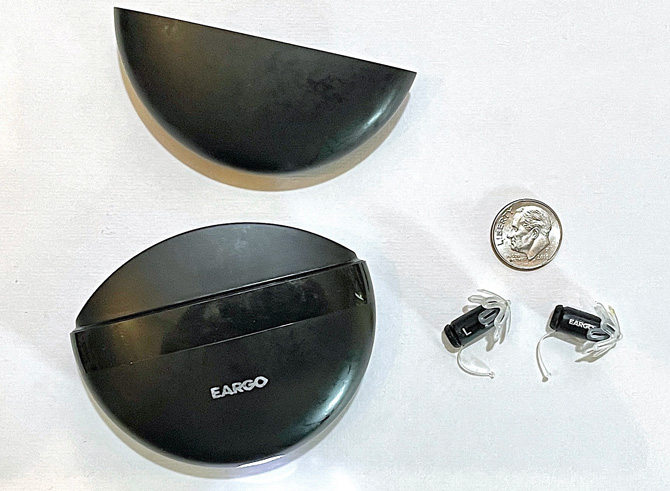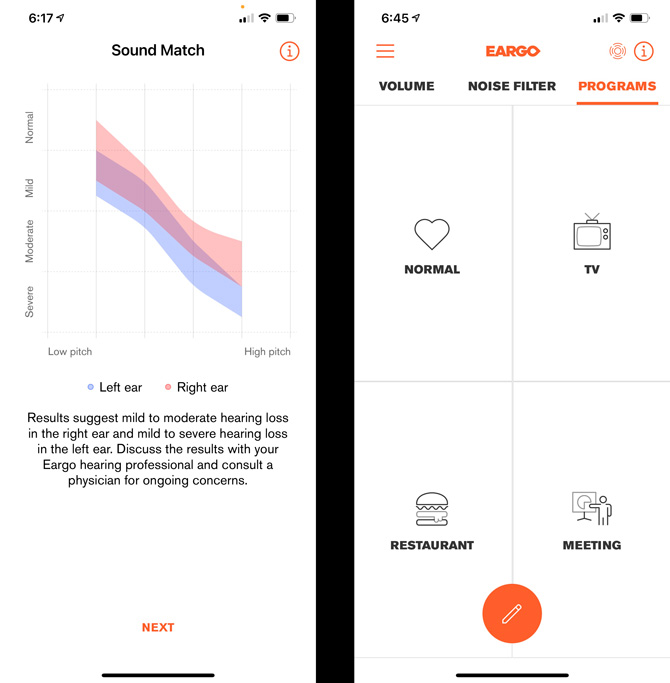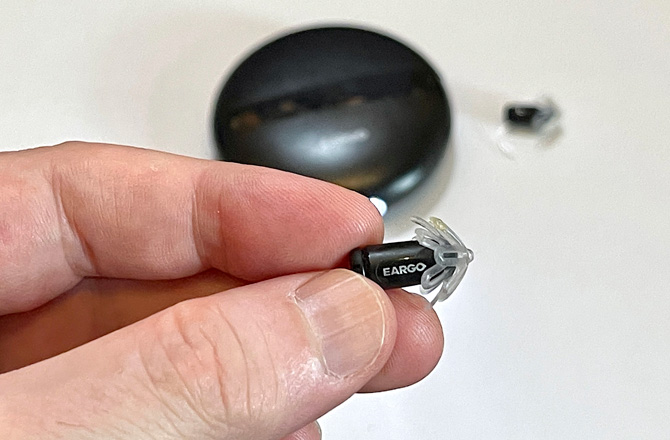We may earn commissions when you buy from links on our site. Why you can trust us.
Review of the Eargo 5
 Over the years, I've tested a variety of over-the-counter hearing assistive devices, some actual FDA-approved hearing aids, others so-called personal sound amplification products (PSAP). Until recently, I believed the best relatively low-cost non-prescription over-the-counter hearing aid available was Eargo's Neo HiFi, which I reviewed 18 months ago. That is until I tested the Neo HiFi's replacement, the Eargo 5, the fifth-generation hearing aid from the company.
Over the years, I've tested a variety of over-the-counter hearing assistive devices, some actual FDA-approved hearing aids, others so-called personal sound amplification products (PSAP). Until recently, I believed the best relatively low-cost non-prescription over-the-counter hearing aid available was Eargo's Neo HiFi, which I reviewed 18 months ago. That is until I tested the Neo HiFi's replacement, the Eargo 5, the fifth-generation hearing aid from the company.

Eargo 5 ($2,950, check price on Amazon) has much in common with its Neo HiFi predecessor, primarily the buds being rechargeable, so there's no need to feed it expensive and bothersome hearing aid batteries. The Eargo 5 is enhanced by five major upgrades:
- Instead of Neo's one-setting-fits-all preset aural tuning, Eargo 5 includes Sound Match, a custom hearing test that creates personalized tunings to fit your specific hearing loss situation, which results in just-right audio boosting performance.
- The Eargo 5 case uses inductive charging rather than the Neo HiFi's contact charging, which means magnets now pull the buds into the precise charging position.
- New petals ear tips in the Eargo 5 are designed for easier maintenance and replacement – they easily snap off and on with a click.
- Eargo has eliminated the Neo HiFi's replaceable wax guards, which eases cleaning and reduces replacement frequency.
- Eargo 5's are 1.5mm shorter than the Neo, and 0.85 grams lighter, making them even more undetectable and invisible than the Neo.
Since my review of the Eargo Neo HiFi, it and the Eargo 5 have been certified as an FDA Class II medical device, which indicates a higher level of functions and capabilities than Class I devices or PSAPs, which merely provide amplification.
After testing it for six weeks, I have a few quibbles with the Eargo 5, but nothing that would prevent me from recommending it. I consider the Eargo 5 to be the best over-the-counter hearing aid on the market. Here's why.
Setting up the Eargo 5
Inside the box, under the Eargo 5's round 2.93 diameter x 0.79-inch charging case, you'll find:
- a quick user guide
- a USB-A to USB-C charging cable and AC transformer
- medium and large closed and open "petal" tips; the buds in the case are pre-fitted with an additional pair of medium closed petals, which will be fine for most folks
- a cleaning tool to remove earwax off the petals, the mic caps, and the battery contacts

The Quick User guide is nice, but it's just an appetizer. The meal is when Eargo hooks you up with an actual audiologist, sessions that are included in the price of the hearing aids. Over a video meet or regular phone call, an audiologist will hand-hold you through the entire setup process – all you need do is make sure the buds are fully charged for four hours (and use the included cable and transformer).
This setup includes completing the Smart Match hearing test. Over the course of 10 minutes or so in a quiet room, you are stepped through a series of test tones in various frequencies and volumes for each ear to establish a custom hearing profile and personalized recommendations and settings. Lacking Sound Match, the Neo HiFi more-or-less supplies one-size-fits-all amplification.
Eargo also offers a dozen short video guides that I recommend you watch if you're considering an Eargo 5 purchase; the videos provide a comprehensive overview of what using and maintaining the Eargo 5 entails.
One of the setup decisions is which petals to use, both the size and either closed or open. According to my Eargo audiologist, Nashville, TN-based Dr. Michele Gotsis: "The open domes are best for most suffering from high-frequency hearing loss due to aging, a.k.a. presbycusis, and noise-induced hearing loss, a.k.a. noise exposure. Anyone with hearing loss in the low frequencies should use closed petals." Eargo's guidance notes that "closed petals maximize amplification across the sound range resulting in a bold, rich listening experience. Open petals provide a different acoustic effect and are for users who may be hearing their own voice too much after multiple days of trying Eargo or are hearing an echo that has not gone away. We encourage users to mix and match to find the right fit."
I tried both types and sizes and found the open petals yielded the most natural and aurally satisfying results for my age-related high-frequency hearing loss. Your mileage may differ.
Using the Eargo 5
Just like true wireless buds, you simply remove each Eargo bud from the case and slip it into your ear canal – like previous Eargos, the buds just lie in your ears. No pushing or twisting is necessary. A gentle female voice then lets you know what program mode each bud is in to let you know they're working, although you'll almost immediately hear the sound boost.
Eargo hasn't made its app much easier to use; thank goodness for Dr. Gotsis, who walked me through the numerous Eargo 5 app options and helped me understand which options I really needed to worry about long-term.
As with the Neo HiFi, you set up to four hearing "programs" such as TV, meeting, or restaurant, all based on your Sound Match results and Eargo's algorithms. Once Dr. Gotsis set up my Eargo 5 buds, she told "Normal covers most circumstances." If you feel compelled to change the program – and I didn't hear much difference between them, but lower hearing levels than mine may produce starker enhancements – you double-tap just in front of each ear to toggle through them or choose the program you want in the app, which worked fine. However, tapping on the program of your choice in the app worked only occasionally and only if you have the charging case with you.

The app's volume settings are unnecessarily confusing. You can change the bud volume in the app, but it only raises or lowers the volume by 2dB each way (for a total of 4dB, which I didn't find detectable). You can apply a noise filter, which kicks in when there's more than 75db-85db or more of annoying ambient sound. Eargo recommends changing some sound settings in your smartphone, which could impact how you adjust your phone's ringer and sound volume. But these settings changes also left me a bit confused about adjusting the Eargo 5 volume. Fortunately, you can forget all about them without any impact on your hearing or the product's functionality.
The sound quality of the Eargo 5
With Sound Match's personalized tuning and appropriate eartips, Eargo 5 amplifies without distortion, filling in your hearing loss potholes and other aural dead spots. At first, you might hear a lot more incidental noise than you're used to – floorboard creaking, faucets that sound like Niagara Falls, light switch switching that sound like gunshots. So Eargo gives you a 45-day trial period to not only make sure you're comfortable with the buds but to allow your brain to assimilate, to adjust to the newly amplified sounds you're now hearing as they fade into normality.
The Eargo 5 is a one-way hearing aid – no Bluetooth. So if you want to take hands-free phone calls or listen to music, you need to slip on a pair of over-the-ear cup-style headphones, which are perfectly comfortable with the Eargo 5 in your ears, and vastly improve your headphone listening. Or, you can remove the Eargo 5 buds and replace them with a pair of true wireless buds with a good hear-through mode when you're traveling. As a third option, there are open ear headphones that will give you the music while still allowing outside sounds in (the best choice for the safety-conscious).
There are over-the-counter two-way Bluetooth hearing aids. However, they are usually behind-ear-style – that tear-drop module that sits behind your ear with the earpiece hooking over your ear, making them far more visible. So, choosing between the nearly invisible one-way Eargo 5 or visible two-way Bluetooth hearing aids boils down to vanity vs. utility.
This one-way vs. two-way hearing aid choice could become moot if you can hold out until sometime next year. That's when the first Bluetooth Audio LE combination hearing aids/true wireless buds are likely to appear.
Considering the driver size requirements for both reproducing high fidelity audio for both music and conversation and the girth required to provide all-day battery life, the ergonomics of a Bluetooth LE Audio hearing aid will likely hue more toward that of a true wireless bud, hardly the invisibility factor the Eargo 5 is designed to deliver.
Charging and Maintenance of the Eargo 5
The Eargo 5 is rated for 16 hours of single-charge operation. In the six-plus weeks I've been wearing them, only twice did I get a "low battery" voice alert. As with the Neos, a half-hour of charging provides a couple of hours of extra listening juice, and a fully charged charging case can provide five complete recharges or five days of AC-free usage. A "Charger battery level" is indicated in the app, but it never displayed a power remaining percentage.
Oh, the USB jack on the bottom of the charging case also conveniently acts like a mini-flashlight, handy for plugging it in on a night table in the dark.
The app allows you to adjust the default reminders to clean your buds and change your petals and mic caps. And you'll want to change the default reminder schedule; those cleaning reminders pile up quickly.
Eargo charges $40 for a tray of three pairs of extra petals or mic caps. Eargo says that both petals and mic caps can get worn over time and recommends both "will need to be changed every two months or once you have noticed… changed or diminished sound quality and/or a less secure fit within the charger."
However, the Eargo 5 petals and mic caps are silicone and plastic, respectively, which makes me cynical about this need for such frequent replacement, which amounts to an additional $160 a year. Silicone, much less hard plastic, both seem to problematically survive for years in landfills and the oceans, so it's hard to believe that simply slipping these tiny buds in your ear once a day for a couple of months can cause enough deterioration to impact detectable performance. Not even my toothbrush wears down that quickly. And I'm not sure how I'd notice subtle sonic changes over eight weeks. Maybe, once you settle on your size and type of petal, order an extra set just in case. But, as long as you keep the petal and caps clean, you should be fine for a while. Unfortunately, as with the Neo HiFi, the Eargo 5 charging case doesn't accommodate the cleaning tool, which is annoying for travelers.
The bottom line

Even with these multiple hearing aid choices, the Eargo 5 hits a specific sweet spot for those suffering hearing loss at half or less the cost of prescription aids: they're nearly perfect for those who would rather not advertise their hearing loss. Once in your ears, the Eargo 5 becomes nearly invisible and, thanks to the Smart Match personalized tuning, restores your youthful hearing, which can be life-changing.
Price: $2,950, currently on sale for $2,550 on Amazon (as of 10/21/2021)
[Image credit: Stewart Wolpin/Techlicious]
Stewart Wolpin has been writing about consumer electronics for more than 35 years, including news, reviews, analysis and history, and has attended and covered nearly 50 Consumer Electronic Shows and around a dozen IFA shows in Berlin. For the Consumer Technology Association (CTA), he is an elector for and writes the official biographies of the annual CT Hall of Fame inductees, and is the keeper of the industry’s official history.
Discussion 
i am 82 yrs old with SS just over $840.00. your aid promises to change my life. sounds wonderful but , unfortunately, there is no way i could possibly afford them. good luck. claire wright
I would like to have somebody from EARGO work an agreement with VA so I could get them from VA . 👍
I am sure what you have is great, but I have excellent hearing and I have emailed you plus spoke to someone working in sales at your company and asked that you please quit blowing up my phone daily with this stuff. Please please please delete my email and my phone number being used for texts for your sales. Thank you















From LANCE EMERSON on October 25, 2021 :: 12:12 pm
I am anxious for Eargo to come up with a smaller Eargo five to fit me.
Reply